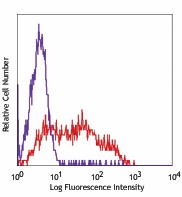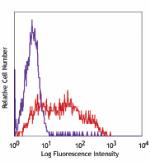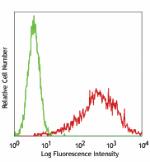- Clone
- 51D6 (See other available formats)
- Regulatory Status
- RUO
- Other Names
- Discoidin domain receptor, DDR1, neuroepithelial tyrosine kinase, epithelial-specific receptor kinase, tyrosine kinase receptor E (trkE), cell adhesion kinase (CAK), PTK3, RTK6
- Isotype
- Mouse IgM, κ
- Ave. Rating
- Submit a Review
- Product Citations
- publications

-

Human DDR1 transfected cells stained with purified 51D6, followed by anti-mouse IgG PE (cross-reactive with all immunoglobulin light chains).
| Cat # | Size | Price | Quantity Check Availability | Save | ||
|---|---|---|---|---|---|---|
| 334002 | 100 µg | 165€ | ||||
The 51D6 monclonal antibody recognizes human CD167a also known as discoidin domain receptor, DDR1, neuroepithelial tyrosine kinase, epithelial-specific receptor kinase, tyrosine kinase receptor E (trkE), cell adhesion kinase (CAK), PTK3, and RTK6. CD167a is a membrane type II receptor kinase, containing a factor VIII-like domain. At least five isoforms are generated through alternative splicing of the kinase domain of human DDR1 gene. These isoforms are named with suffixes a to e. CD167a is expressed on epithelial cells, keratinocytes, leukocytes, monocytes and has been reported to be overexpressed in some breast carcinomas. CD167a expression can be upregulated by p53. CD167a has been reported to interact with a variety of proteins including collagen type II alpha 1, collagen type III alpha 1, collagen type V alpha 2, collagen type XI alpha 1, phospholipase gamma 1, SHC, and the lipid-anchored docking protein FRS2. CD167a can be phosphorylated on Y513. Animal studies suggest that CD167a is involved in arterial wound healing. The 51D6 antibody has been shown to be useful for flow cytometric detection of human CD167a as well as immunoprecipitation.
Product DetailsProduct Details
- Verified Reactivity
- Human
- Antibody Type
- Monoclonal
- Host Species
- Mouse
- Immunogen
- NIH-3T3 cells transfected with human DDR1 (CD167a)
- Formulation
- Phosphate-buffered solution, pH 7.2, containing 0.09% sodium azide.
- Preparation
- The antibody was purified by affinity chromatography.
- Concentration
- 0.5 mg/ml
- Storage & Handling
- The antibody solution should be stored undiluted between 2°C and 8°C.
- Application
-
FC - Quality tested
IP - Reported in the literature, not verified in house - Recommended Usage
-
Each lot of this antibody is quality control tested by immunofluorescent staining with flow cytometric analysis. For flow cytometric staining, the suggested use of this reagent is ≤2.0 µg per million cells in 100 µl volume. It is recommended that the reagent be titrated for optimal performance for each application.
- Application Notes
-
Additional reported (for the relevant formats) applications include:immunoprecipitation.
- RRID
-
AB_1134243 (BioLegend Cat. No. 334002)
Antigen Details
- Structure
- Membrane Type II receptor kinase, containing a factor VIII-like domain. Three isoforms have been reported. Predicted molecular weights are: isoform 1, approximately 101.5 kD, isoform 2, approximately 101 kD, and isoform 3 approximately 97 kD.
- Distribution
-
Epithelial cells, keratinocytes, and activated leukocytes. Overexpressed in some breast carcinomas. Expression can be upregulated by p53.
- Function
- Receptor membrane tyrosine kinase. May be involved in arterial wound repair.
- Interaction
- CD167a has been reported to interact with a variety of proteins including collagen type II alpha 1, collagen type III alpha 1, collagen type V alpha 2, collagen type XI alpha 1, phospholipase gamma 1, SHC, lipid-anchored docking protein FRS2
- Modification
- Phosphorylation (Y513)
- Cell Type
- Epithelial cells, Leukocytes
- Biology Area
- Immunology
- Molecular Family
- Adhesion Molecules, CD Molecules
- Antigen References
-
1. DiMarco E, et al. 1993. J. Biol. Chem. 268:24290.
2. Hou G, et al. 2001. J. Clin. Invest. 107:727.
3. Johnson JD, et al. 1993. Proc. Natl. Acad. Sci. USA 90:5677.
4. Sakuma S, et al. 1996. FEBS Lett. 398:165. - Gene ID
- 780 View all products for this Gene ID
- UniProt
- View information about CD167a on UniProt.org
Related Pages & Pathways
Pages
Other Formats
View All CD167a Reagents Request Custom Conjugation| Description | Clone | Applications |
|---|---|---|
| Purified anti-human CD167a (DDR1) | 51D6 | FC,IP |
| PE anti-human CD167a (DDR1) | 51D6 | FC |
Compare Data Across All Formats
This data display is provided for general comparisons between formats.
Your actual data may vary due to variations in samples, target cells, instruments and their settings, staining conditions, and other factors.
If you need assistance with selecting the best format contact our expert technical support team.
-
Purified anti-human CD167a (DDR1)

Human DDR1 transfected cells stained with purified 51D6, fol... -
PE anti-human CD167a (DDR1)

Human DDR1 transfected cells stained with 51D6 PE
 Login / Register
Login / Register 








Follow Us